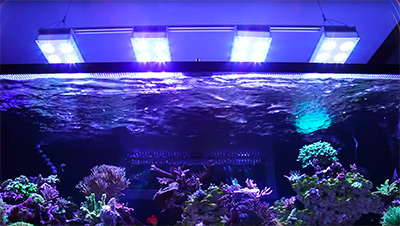Lighting is important because it directly affects how we visually enjoy the hobby and, more importantly, the vast majority of the corals in our tanks are photosynthetic. In this two-part article, we will first cover some of the basics of the light itself and then discuss the various lighting technologies people use to light their reefs.
Coral and zooxanthellae
Coral as we know it is a symbiotic relationship between the coral animal and dinoflagellates called zooxanthellae. Zooxanthellae live in the tissue of the coral and are like algae in that they contain chlorophyll for photosynthesis. The byproducts of photosynthesis are things like simple sugars that the coral hosts can use as an energy source. It is for this reason that coral are often described to the layperson as having traits of both plants and animals.
The color of zooxanthellae is varying degrees of brown. However, there are over 80 known varieties of zooxanthellae. So, a coral can have a different appearance depending on which types live in it.
Corals occasionally expel zooxanthellae to control both the amount of dinoflagellates and the varieties residing in their tissues. This is easiest to observe in LPS, where one might see brown, stringy material getting spit out. This is usually done to adjust for some change in the environment or as a stress reaction. The unfortunate bleaching of natural coral reefs is the result of corals expelling their zooxanthellae as a last resort to survive their changing environment.
The color of light is important not only for aesthetics, but also for the photosynthetic process. Chlorophyll in zooxanthellae does not absorb light uniformly. There are certain spectrums of light that are absorbed highly and other spectrums that are rejected. The type of chlorophyll most commonly found in corals is Chlorophyll A, and it has two major absorption peaks—one at the 440nm wavelength, which is a violet light, and the other at the 675nm wavelength, which is a red light. Light spectrums neighboring those spectral peaks are also absorbed by Chlorophyll A but also by different compounds such as Chlorophyll C and carotenoids, so it is important for whatever lighting you choose to have a robust spectrum outside of just the 675nm and 440nm spectral peaks.
Color temperature
The color of light is measured by a Kelvin rating. If you recall from high school physics and chemistry, Kelvin is basically Celsius but starts at absolute zero rather than the freezing point of water. So zero degrees Kelvin is equivalent to -273.15 degrees Celsius. Anyhow, once you start turning up the temperature, this theoretical black body starts to emit light. The best way to visualize this is to imagine a star. Our sun burns at just under 6,000K, and we get that yellow light as a result.
Once you get to about 8,000K to 10,000K in temperature, the black body radiates white light. Between 15,000K and 25,000K, the radiation appears blue. So just to clarify, the bulbs in your tank that are 10,000K are not burning at that temperature; they are just similar in color to a star that is actually burning that hot.
A common misconception about higher-Kelvin light bulbs is that they necessarily have more blue than lower Kelvin bulbs that appear more yellow. The blue light in these bulbs is achieved by reducing the red, green, and yellow phosphors. It’s entirely possible for a 6,500K, yellow-looking bulb to have a great deal more blue spectrum available for photosynthesis than a 20,000K bulb.
Still, there are perks to using higher-Kelvin bulbs. Bluer light is aesthetically pleasing and has the side perk of algae control, as algae tends to rely more on the reds, yellows, and greens compared to coral.
Having said that, lower-Kelvin bulbs grow coral faster. Possibly the best bulb I have ever seen at growing corals was the 6500K Iwasaki, although it was arguably the least attractive color unless you want a very yellow-looking shallow-water reef.
Light intensity
When I started in reefkeeping, the rule was to get the brightest lighting possible. End of story. The most I have ever had on a tank was two 400W metal halides and four 110W VHO fluorescents over a 75-gallon tank. Needless to say, it was bright and warm.
Fast forward about 20-something years, and I have some corals in extremely dimly lit tanks doing just fine. So in the bright-tank example, the intensity was probably close to 1200 PAR if not more. In my low-light setup, the PAR was about 50. In both cases, coral grew just fine. In fact, with the exception of Acropora, the vast majority of the corals we keep here do quite well in low light. What seems to be more important than raw intensity is consistency.
Don’t miss Part 2!
Be sure to come back on Friday for part two of The Deep Dive on Reef Aquarium Lighting, which will cover all the different lighting technologies available to reefkeepers today.



